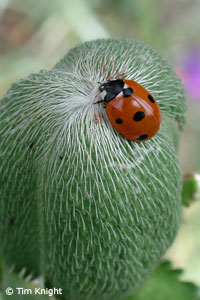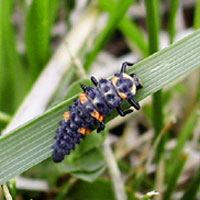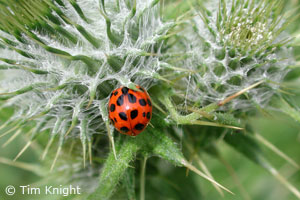

|
Ladybug Coccinellidae Description: Lady beetles, ladybugs, or ladybird beetles are among the most visible and best known beneficial predatory insects. Over 450 species are found in North America. Some are native to the United States and some have been introduced from other countries. Coccinellids are generally considered useful insects as many species feed on aphids or scale insects, which are pests in gardens, agricultural fields, orchards, and similar places. 
Adult lady beetles are small, round to oval, and dome-shaped. The most well known have black markings on red, orange, or yellow forewings (elytra), but some are black. The area immediately behind the head, the pronotum, may also have a distinctive pattern. The color and pattern of markings for each species may vary, but can aid identification. Coccinellids are brightly colored to ward away potential predators. This defense works because most predators associate bright colors (especially orange and black or yellow and black) with poison and other unpleasant properties. 
Lady beetle larvae are dark and alligator-like with three pairs of prominent legs. They are spiny and black with bright spots. How big are they? These insects are about 1 cm long. The growing larvae range from 1 mm (1/25") to about 1 cm (3/8") in length. Range / Habitat: The Lady Bug is found throughout the United States. They can be found in open habitats including gardens, fields, meadows, and roadsides. Diet: Lady beetles need to eat many aphids per day so that they can lay eggs. The convergent lady beetle may eat its weight in aphids every day as a larva and consume as many as 50 aphids per day as an adult. Seven-spotted lady beetle adults (pictured above) may consume several thousand aphids in its lifetime. Each larvae eats 200 to 300 aphids as it grows. Introduced Species: The species found so abundantly is the multicolored Asian lady beetle, Harmonia axyridis, common in Japan, Korea and other parts of Asia. "Multicolored" refers to the tremendous color variations in this species, ranging from black with two red spots, to orange with 19 black spots, with every combination in between. This species was introduced by USDA Agricultural Research scientists in the late 1970's and early 1980's as a biological control agent for pear psylla and other soft bodied insects. Numerous releases occurred in the United States; high populations have been reported in Washington, Oregon, Georgia and Virginia. Releases in Washington State were in Chelan, Klickitat and Yakima Counties, all east of the Cascade Mountains. The insects apparently did not establish in eastern Washington, but chose to relocate in western Washington. Others may have arrived here as unintentional passengers aboard cargo ships. (WSU Extension) Did you know?

Asian Lady Beetle in an urban garden. Definitions:
Elytra - either of the front wings in beetles and some other insects which cover and protect the functional hind wings Larva - the immature free-living form of most invertebrates and amphibians and fish which at hatching from the egg is fundamentally unlike its parent and must metamorphose More Information Lady Beetles - Cornell University Lady Beetles - Washington State University Ladybugs - University of Kentucky Photo credits: photos © Tim Knight Home | About Us | How to Participate | Biodiversity Modules | Projects | Maps | News | Resources |